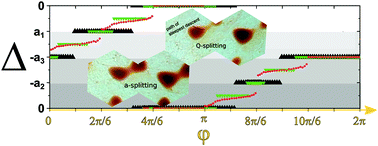Hard topological versus soft geometrical magnetic particle transport†
Abstract
The question of how a dissipative geometrical transport system changes towards a topological transport system is important to render a fragile transport into a robust transport. We show how a macroscopic magnetic topological transport of solid state spheres changes to a geometrical transport of ferrofluid droplets, when instead of a solid state object, soft matter is transported. The key difference when comparing solid objects with fluid droplets is the possibility to split a ferrofluid droplet into two droplets. It is shown how this fundamental difference also fundamentally changes the transport properties. Hence, experimentally and theoretically the transport on top of a periodic two-dimensional hexagonal magnetic pattern of (i) a single macroscopic steel sphere, (ii) a doublet of wax/magnetite composite spheres, and (iii) an immiscible mixture of ferrofluid droplets with a perfluorinated liquid is analyzed. The transport of all these magnetic objects is achieved by moving an external permanent magnet on a closed modulation loop around the two-dimensional magnetic pattern. The transport of one and also that of two objects per unit cell is topologically protected and characterized by discrete displacements of the particles as we continuously scan through a family of modulation loops. The direction and the type of transport are characterized by the winding numbers of the modulation loops around special objects in control space, which is the space for the possible directions of the external magnetic field. The winding numbers necessary for characterizing the topological transport increase with the number of particles per unit cell. The topological character of the transport is destroyed, when transporting a large collection of particles per unit cell, like it is in the case of a macroscopic assembly of magnetic nanoparticles in a ferrofluid droplet for which the transport is geometrical and no longer topological. To characterize the change in the transport from topological to geometrical, we perform computer simulations of the transport of an increasing number of particles per unit cell.



 Please wait while we load your content...
Please wait while we load your content...